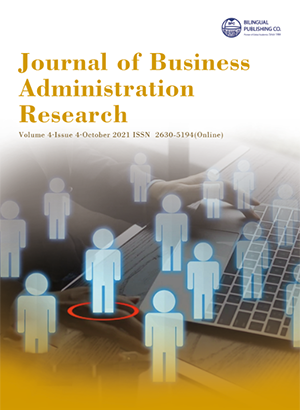Talent Value Creation during Digital Transformation: A Inductive Model of HR Reengineering
DOI:
https://doi.org/10.30564/jbar.v4i4.3703Abstract
In this study, we are to explore (1) features of HR reengineering, (2) the impact of business digitalization strategies on digital transformation and HR engineering, (3) the impact of business digitalization strategies and HR reengineering on talent value creation, and present the results of a qualitative study that offers insight into 42 “thought units”, which were “categorizing” into four dimensions corresponding to our research questions: (1) plan, (2) do, (3) check, and (4) action. The “check” dimension corresponds to the four key features of HR reengineering related to business digitalization strategy, and how to create talent value when a company successfully implements business-led digital transformation, HR reengineering, and talent value creation, including (1) talent planning, (2) talent introduction, (3) talent adjustment, and (4) talent development.Keywords:
Talent value creation; Digital transformation; HR reengineering; Qualitative studyReferences
[1] Ayesha, N., Babak, A., Narciso, C., & Chew, E. (2018). Digital transformation & digital Business strategy in electronic commerce - The role of organizational capabilities. Journal of Theoretical and Applied Electronic Commerce Research, 13(2), I-VIII.
[2] Svahn, F., Mathiassen, L., & Lindgren, R. (2017). Embracing digital innovation in incumbent firms: How Volvo cars managed competing concerns. MIS Quarterly, 41(1), 239-253.
[3] Setia, P., Venkatesh, V., & Joglekar, S. (2013). Leveraging digital technologies: How information quality leads to localized capabilities and customer service performance, MIS Quarterly, 37(2), 565-590.
[4] Sia, S.K., Soh, C., & Weill, P. (2016). How DBS Bank Pursued a Digital Business Strategy. MIS Q Executive.
[5] Hess, T., Matt, C., Wiesbock, F., & Benlian, A. (2016). Options for formulating a digital transformation strategy. MIS Quarterly Executive, 15(2), 103-119.
[6] Karami, J., & Walter, Z. (2015). The role of dynamic capabilities in responding to digital disruption: A factor based study of the newspaper industry. Journal of Management Information System, 32(1), 39- 81.
[7] Mithas, S., Tafti, A., & Mitchell, W. (2013). How a firm’s competitive environment and digital strategic posture influence Digital Business Strategy. MIS Quarterly, 37(2), 511- 536.
[8] Bharadwaj, A., Sawy, O.A.E., Pavlou, P.A., & Venkatraman, N. (2013). Digital business strategy: Toward a next generation of insights. MIS Quarterly, 37(2), 471-482.
[9] Mathrani, S., Matharni, A., & Veihland, V. (2012). Using enterprise systems to realize digital business strategies. Journal of Enterprise Information Management, 42(5), 9-17.
[10] Sawy, O.A.E., Kraemmergaard, P., Amsinck, H., & Vinther, A.L. (2016). How LEGO built the foundations and enterprise capabilities for digital leadership. MIS Quarterly Executive, 15(2), 141-166.
[11] Westerman, G., & Bonnet, D. (2015). Revamping your business through digital transformation. MIT Sloan Management Review, 56(3), 10-13.
[12] Makram, H. Sparrow, P. Greasley, K., (2017). How do strategic actors think about the value of talent management? Moving form talent practice to the practice of talent. Journal of Organizational Effectiveness, 4(4), 259-378.
[13] Willmott, H. (1994). Business process re-engineering and human resource management, Personnel Review, 23(3), 34-46.
[14] Brent, K., & Finegold, D. (1996). Adding value in banking: human resource innovations for service firms. Sloan Management Review, 38(1). 57-69.
[15] Newman, K., Cowling, A., & Leigh, S. (1998). Case study: Service quality, business process re-engineering and human resources: A case in point? The International Journal of Bank Marketing, 16(6), 225-242.
[16] Cowling, A., & Newman, K. (1995). Banking on people: TQM, service quality and human resources. Personnel Review, 24(7), 25-40.
[17] Treviňo, L. K., Brown, M., & Hartman, L. P. (2003). A qualitative investigation of perceived executive ethical leadership: Perceptions from inside and outside the executive suite. Human Relations, 56(1), 5-37.
[18] Silverman, D. (2005). Doing Qualitative Research. Trowbridge, Wiltshire: Sage Publications.
[19] Kerr, S., Harlan, A., & Stodgill, R. M. (1974). Preference for motivator and hygiene factors in a hypothetical interview situation. Personnel Psychology, 27(1), 109-124.
[20] Aspers, P. (2009). Empirical phenomenology: A qualitative research approach. The Indo-Pacific Journal of Phenomenology, 9(2), 1-12.
[21] Eisenhardt, K. M. (1989). Building Theories from Case Study Research. Academy of Management Review, 14(4), 532-550.
[22] Strauss, A., & Corbin, J. (1998). Basics of Qualitative Research: Procedures and Techniques for Developing Grounded Theory. Thousand Oaks, CA: Sage.
[23] Turner, B. A. (1981). Some practical aspects of qualitative data analysis. Quality and Quantity, 15, 225- 47.
[24] Charmaz, K. (2006). Constructing Grounded Theory: A Practical Guide through Qualitative Analysis. Thousand Oaks, CA: Sage Publications.
[25] Kruegar, R. A. (1994). Focus Groups. Sage, Thousand Oaks, CA.
[26] Glaser, B. G., & Strauss, A. L. (1967). The Discovery of Grounded Theory. Chicago, IL: Aldine.
Downloads
Issue
Article Type
License
Copyright and Licensing
The authors shall retain the copyright of their work but allow the Publisher to publish, copy, distribute, and convey the work.
Journal of Business Administration Research publishes accepted manuscripts under Creative Commons Attribution-NonCommercial 4.0 International License (CC BY-NC 4.0). Authors who submit their papers for publication by Journal of Business Administration Research agree to have the CC BY-NC 4.0 license applied to their work, and that anyone is allowed to reuse the article or part of it free of charge for non-commercial use. As long as you follow the license terms and original source is properly cited, anyone may copy, redistribute the material in any medium or format, remix, transform, and build upon the material.
License Policy for Reuse of Third-Party Materials
If a manuscript submitted to the journal contains the materials which are held in copyright by a third-party, authors are responsible for obtaining permissions from the copyright holder to reuse or republish any previously published figures, illustrations, charts, tables, photographs, and text excerpts, etc. When submitting a manuscript, official written proof of permission must be provided and clearly stated in the cover letter.
The editorial office of the journal has the right to reject/retract articles that reuse third-party materials without permission.
Journal Policies on Data Sharing
We encourage authors to share articles published in our journal to other data platforms, but only if it is noted that it has been published in this journal.




 Hsiu-Hua Hu
Hsiu-Hua Hu

